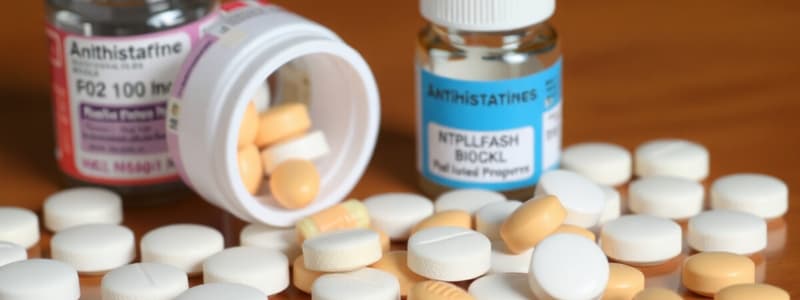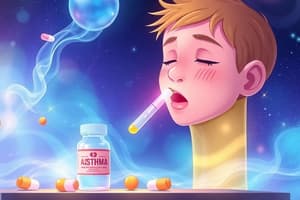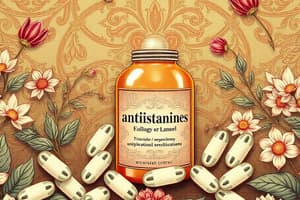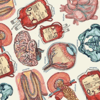Podcast
Questions and Answers
What should a patient avoid when using nasal decongestants?
What should a patient avoid when using nasal decongestants?
- Taking them as prescribed
- Using them during a cold
- Using them continuously for more than 2 weeks (correct)
- Mixing them with other nasal medications
Which of the following is a common treatment for xerostomia?
Which of the following is a common treatment for xerostomia?
- Brushing teeth more frequently
- Consuming sour foods
- Using over-the-counter artificial saliva products (correct)
- Increasing caffeine intake
What is a key instruction for a patient using albuterol for an asthma attack?
What is a key instruction for a patient using albuterol for an asthma attack?
- Use it every hour as needed
- Rinse the mouth after use (correct)
- Use it only during exercise
- Wait 5 minutes between puffs
What is a significant side effect associated with cholestyramine?
What is a significant side effect associated with cholestyramine?
When should a patient be cautious with propranolol?
When should a patient be cautious with propranolol?
Which medication is a bronchodilator that should not be given to asthma patients?
Which medication is a bronchodilator that should not be given to asthma patients?
What is the maximum number of doses of nitroglycerin a patient can take in 15 minutes?
What is the maximum number of doses of nitroglycerin a patient can take in 15 minutes?
What is the recommended action if atenolol is being considered for a patient with asthma?
What is the recommended action if atenolol is being considered for a patient with asthma?
What is the primary action of Digoxin?
What is the primary action of Digoxin?
Which laboratory test is crucial for monitoring patients on Warfarin?
Which laboratory test is crucial for monitoring patients on Warfarin?
What should be monitored closely to prevent Digoxin toxicity?
What should be monitored closely to prevent Digoxin toxicity?
What condition is associated with Ceftriaxone when allergic to penicillin?
What condition is associated with Ceftriaxone when allergic to penicillin?
Which side effect is most commonly associated with Aminoglycosides?
Which side effect is most commonly associated with Aminoglycosides?
What is a key instruction for taking Ferrous Sulfate with antibiotics?
What is a key instruction for taking Ferrous Sulfate with antibiotics?
What is a major adverse reaction associated with 1st generation antihistamines?
What is a major adverse reaction associated with 1st generation antihistamines?
What is the recommended action if a patient experiences an anaphylactic reaction?
What is the recommended action if a patient experiences an anaphylactic reaction?
Which symptom indicates the use of antihistamines?
Which symptom indicates the use of antihistamines?
What is the purpose of the antidote Protamine Sulfate?
What is the purpose of the antidote Protamine Sulfate?
What is a characteristic of 2nd generation antihistamines compared to 1st generation?
What is a characteristic of 2nd generation antihistamines compared to 1st generation?
Which of the following is a use of antitussives?
Which of the following is a use of antitussives?
What is a common adverse reaction of centrally acting antitussives?
What is a common adverse reaction of centrally acting antitussives?
What type of cough is codeine indicated for?
What type of cough is codeine indicated for?
Dextromethorphan is classified as what type of antitussive?
Dextromethorphan is classified as what type of antitussive?
Which agent is known to thin respiratory secretions?
Which agent is known to thin respiratory secretions?
What is the maximum daily dose of ibuprofen for adults?
What is the maximum daily dose of ibuprofen for adults?
Which medication should NOT be given to patients with heart failure?
Which medication should NOT be given to patients with heart failure?
What is the major adverse reaction associated with using Fentanyl?
What is the major adverse reaction associated with using Fentanyl?
Which of the following medications is contraindicated for children due to the risk of Reye’s syndrome?
Which of the following medications is contraindicated for children due to the risk of Reye’s syndrome?
What should a nurse monitor for when a patient is taking Methotrexate?
What should a nurse monitor for when a patient is taking Methotrexate?
Which symptom indicates salicylism, or aspirin toxicity?
Which symptom indicates salicylism, or aspirin toxicity?
What dietary advice is important for patients taking Hydrochlorothiazide?
What dietary advice is important for patients taking Hydrochlorothiazide?
When administering insulin, what is the recommended timeframe for feeding the patient?
When administering insulin, what is the recommended timeframe for feeding the patient?
Which medication is known for causing discoloration of urine to bright orange?
Which medication is known for causing discoloration of urine to bright orange?
What is the first-line treatment for hypotension?
What is the first-line treatment for hypotension?
Flashcards
Antihistamines - What is histamine?
Antihistamines - What is histamine?
Histamine is a chemical released by the body during allergic reactions and tissue injury, causing inflammation.
Antihistamines - How do they work?
Antihistamines - How do they work?
Antihistamines block the effects of histamine, reducing inflammation and allergy symptoms.
Antihistamines - 1st Generation
Antihistamines - 1st Generation
First-generation antihistamines can cause drowsiness due to their effects on the brain.
Antihistamines - Uses
Antihistamines - Uses
Signup and view all the flashcards
Antitussives - How do they work?
Antitussives - How do they work?
Signup and view all the flashcards
Antitussives - When to use?
Antitussives - When to use?
Signup and view all the flashcards
Codeine - What is it?
Codeine - What is it?
Signup and view all the flashcards
Expectorants - How do they work?
Expectorants - How do they work?
Signup and view all the flashcards
Overuse of Nasal Decongestants
Overuse of Nasal Decongestants
Signup and view all the flashcards
Xerostomia
Xerostomia
Signup and view all the flashcards
Albuterol
Albuterol
Signup and view all the flashcards
Montelukast
Montelukast
Signup and view all the flashcards
SABA (Short-Acting Beta 2 Agonist)
SABA (Short-Acting Beta 2 Agonist)
Signup and view all the flashcards
Nitroglycerin
Nitroglycerin
Signup and view all the flashcards
Verapamil
Verapamil
Signup and view all the flashcards
Propranolol vs Atenolol
Propranolol vs Atenolol
Signup and view all the flashcards
Nitro Patch
Nitro Patch
Signup and view all the flashcards
Heparin
Heparin
Signup and view all the flashcards
Coumadin/Warfarin
Coumadin/Warfarin
Signup and view all the flashcards
Digoxin
Digoxin
Signup and view all the flashcards
Schedule B Controlled Substances
Schedule B Controlled Substances
Signup and view all the flashcards
Schedule 1 Controlled Substances
Schedule 1 Controlled Substances
Signup and view all the flashcards
Idiosyncrasy
Idiosyncrasy
Signup and view all the flashcards
Super Infection
Super Infection
Signup and view all the flashcards
Aspirin - Max Dose
Aspirin - Max Dose
Signup and view all the flashcards
Aspirin - Uses
Aspirin - Uses
Signup and view all the flashcards
Aspirin - Risk
Aspirin - Risk
Signup and view all the flashcards
Ibuprofen - Max Dose
Ibuprofen - Max Dose
Signup and view all the flashcards
Ibuprofen - Risk
Ibuprofen - Risk
Signup and view all the flashcards
Celecoxib - Unique Property
Celecoxib - Unique Property
Signup and view all the flashcards
Celecoxib - Contraindication
Celecoxib - Contraindication
Signup and view all the flashcards
Salicylism
Salicylism
Signup and view all the flashcards
Morphine - Monitoring
Morphine - Monitoring
Signup and view all the flashcards
Naloxone (Narcan)
Naloxone (Narcan)
Signup and view all the flashcards
Study Notes
Antihistamines
- Histamine is produced in response to allergic reactions or tissue injury, triggering an inflammatory response.
- First-generation antihistamines can cause drowsiness as a side effect.
- Uses include relief from seasonal and perennial allergies, allergic rhinitis, conjunctivitis, and mild angioedema/urticaria. They may also be used to treat allergic reactions to drugs/blood/plasma, coughs, and Parkinson's-like symptoms, and nausea/vomiting.
- Second-generation antihistamines (e.g., Loratadine) cause less drowsiness and fewer anticholinergic effects compared to first-generation.
Adverse Reactions
- Central Nervous System: Drowsiness, sedation, and disturbed coordination are possible reactions.
- Respiratory System: Dryness of the mouth, nose, and throat, plus thickening of bronchial secretions.
- Other: Skin rashes (e.g., Urticaria) can occur as a potential drug allergy.
Antitussives
- Centrally acting antitussives, like codeine, work by numbing stretch receptors in the respiratory passage, thus reducing coughs. They are only useful for nonproductive coughs.
- Adverse reactions may include sedation, sweating, headaches, dizziness, lethargy, and confusion.
- Drowsiness and other CNS depressants can have additive effects when used together, especially with codeine.
- Dextromethorphan is a nonopioid antitussive, useful for symptomatic cough relief in cases of nonproductive coughs.
Expectorants
- Expectorants (e.g., Guaifenesin) thin respiratory secretions, aiding in their removal.
- They are often used to help with productive coughs, particularly associated with respiratory infections like sinusitis, asthma, bronchitis, and pharyngitis.
Nasal Decongestants
- Overuse of nasal decongestants can lead to rebound nasal congestion.
- Oxymetazoline (Afrin) is an example used for nasal congestion, reducing swelling and inflammation, and is used for treating the common cold, hay fever, sinusitis, and allergic rhinitis.
Bronchodilators
- Bronchodilators (e.g., Albuterol) are used to treat bronchospasm and wheezing and are used for emergency asthma attacks.
- Side effect: Wheezing, crackles, and constriction of bronchioles (lumens).
Other Medications
- Montelukast (Singulair): A bronchodilator. Do not use in asthmatic patients.
- SABA (short acting beta 2 agonist): Activates sympathetic nervous system, potentially causing high blood pressure, cardiac arrhythmias, and tachycardia.
- Antihyperlipidemic Drugs: can increase cholesterol levels
- Cholestyramine: Has constipation as a major side effect.
- HDL and LDL are types of lipids (fats) in the blood. Good healthy fats (HDL) are helpful and bad unhealthy fats (LDL) should be reduced.
Specific Medication Notes
- Propranolol, Atenolol: The patient needs to be educated about how to monitor their blood pressure. Never administer Atenolol if the patient has a history of asthma.
- Nitroglycerin: Take 1 dose every 5 minutes, up to 3 doses total within 15 minutes.
- Verapamil: Should be administered even if the heart rate is normal, as the drug is intended for maintaining heart rate, rather than directly affecting it.
Other
- Schedule B controlled substances have lower abuse potential, while Schedule I controlled substances have the highest potential.
- Idiosyncrasy refers to unusual or abnormal responses to medications.
- SJS (Stevens-Johnson Syndrome): a severe skin reaction, with rashes, mouth sores, and skin lesions.
- Sulfonamides: Used to treat UTIs; increase fluid intake to 2000ml a day. Watch for crystals in the urine.
- Anaphylactic Shock: a severe allergic reaction.
Studying That Suits You
Use AI to generate personalized quizzes and flashcards to suit your learning preferences.
Related Documents
Description
This quiz covers the essential aspects of antihistamines, including their mechanisms, classifications, and common adverse reactions. It also explores the role of antitussives in treating coughs, helping you understand their uses and side effects. Test your knowledge on these important medications and their impact on health.





